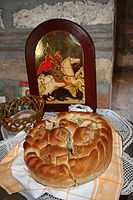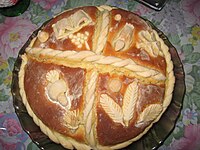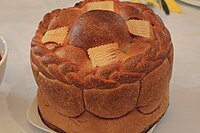
| Part of a series on the |
| Culture of Serbia |
|---|
 |
| People |
| Mythology and Folklore |
| Cuisine |
| Festivals |
| Sport |
Slavski kolač ( Serbian Cyrillic: Славски колач) is a traditional Serbian cake (a type of yeast bread). It is made for the Orthodox Christian celebration of Slava, a UNESCO's Representative List of the Intangible Cultural Heritage of Humanity. [1] [2] [3] The parish priest visits the family to consecrate the kolač and red wine, and to light a beeswax candle stamped with an image of the saint. [1] [2] [3]
Often extended family and friends are invited to the celebration. Wine is poured over the cake, and it is cut or broken by members of the family before lunch. [4] [2]
Significance
The custom of Slava and the importance of the celebration cake are found only among Serbs. [1] [2] [3] [5] It celebrates home liturgy, domesticity, family gatherings, and family tradition. [5] Slavski kolač, along with the candle and a wheat dish such as žito (koljivo), are present at all Slava celebrations and are considered the crucial elements. [3] [6] [7]
The cake symbolizes of the body of Jesus, and the wine with which the cake is eaten represents his blood. Traditionally a woman made the bread the day before the celebration, after bathing, dressing in clean clothing, saying the Lord's Prayer, and crossing herself. [8] Tradition calls for the dough to be made with consecrated water. [9] [7]
During the coronavirus pandemic, health authorities advised that it was not necessary to take the cake to church, that singing was not necessary for the celebration, and that the gatherings should be limited to household members. [10] [6]
Description
The kolač is a round yeast breadlike cake approximately 15 centimetres (6 in) high. [1] Traditionally, braided dough is wrapped around the rim and a dough cross is pressed into the center of the dough, dividing the loaf into quarters. [1] Each quarter gets further decoration, such a Cyrillic "C", which stands for samo, sloga, Srbina, spasava, meaning "Only unity will save the Serbs". [1] Around the rim the letters "ИС ХС НИ КА" ( Cyrillic), an abbreviation for "Jesus Christ Conquers". [1] [8] [7] Every baker has her own style of decoration. [5] [11]
Consecration
The parish priest visits the family to consecrate the kolač and red wine, and to light a beeswax candle stamped with an image of the saint. [1] [2] [3] Some families instead take the cake to church to be consecrated. [10] [7]
After the cake is consecrated, wine is poured over the cake. The woman of the household cuts it into quarters and turns it cut-side up. It is further cut into pieces by other family members and oldest or most important guests. [4] [2]
Gallery
-
Celebration cake in the church of Sv. John the Baptist in Nakučani
See also
References
- ^ a b c d e f g h Rolek, Barbara (28 July 2019). "Krsna Slava Is a Serbian Family's Patron Saint Day". The Spruce Eats. Retrieved 2021-09-02.
- ^ a b c d e f "La Slava, celebration of the feast of the patron saint of the family". UNESCO (in French). 2014. Retrieved 2021-09-02.
- ^ a b c d e Gercevic, Srdjan (2016-11-28). "Slava: Hygge, Serbian-Style". Balkan Insight. Retrieved 2021-09-02.
- ^ a b "Slavski Kolac (or) Slavska Pogaca (or) Krsni Kruh (In Serbian)". Zdravo - ja sam aleksandra. Retrieved 19 August 2021.
- ^ a b c Mitić, Lj. (18 December 2019). "A traditional cake with the spice of every housewife". Južne vesti (in Serbian). Retrieved 2021-09-02.
- ^ a b "How to celebrate Slava in the time of coronavirus". Danas (in Serbian). 14 November 2020. Retrieved 2021-09-02.
- ^ a b c d Montgomery, David W. (2018-11-26). Everyday Life in the Balkans. Indiana University Press. ISBN 978-0-253-03820-3.
- ^ a b "Slavski kolač". Stil Magazin.
- ^ "How not to make your celebration cake bloom on the surface". Telegraf.rs (in Serbian). 16 December 2020. Retrieved 2021-09-02.
- ^ a b "Dr Kon Advises Believers: The feast cake does not have to be carried to church, and singing is not necessary". Novosti AD (in Serbian). 27 October 2020. Retrieved 2021-09-02.
- ^ "What every decoration on a celebration cake mean". Telegraf.rs (in Serbian). 27 October 2016. Retrieved 2021-09-02.

| Part of a series on the |
| Culture of Serbia |
|---|
 |
| People |
| Mythology and Folklore |
| Cuisine |
| Festivals |
| Sport |
Slavski kolač ( Serbian Cyrillic: Славски колач) is a traditional Serbian cake (a type of yeast bread). It is made for the Orthodox Christian celebration of Slava, a UNESCO's Representative List of the Intangible Cultural Heritage of Humanity. [1] [2] [3] The parish priest visits the family to consecrate the kolač and red wine, and to light a beeswax candle stamped with an image of the saint. [1] [2] [3]
Often extended family and friends are invited to the celebration. Wine is poured over the cake, and it is cut or broken by members of the family before lunch. [4] [2]
Significance
The custom of Slava and the importance of the celebration cake are found only among Serbs. [1] [2] [3] [5] It celebrates home liturgy, domesticity, family gatherings, and family tradition. [5] Slavski kolač, along with the candle and a wheat dish such as žito (koljivo), are present at all Slava celebrations and are considered the crucial elements. [3] [6] [7]
The cake symbolizes of the body of Jesus, and the wine with which the cake is eaten represents his blood. Traditionally a woman made the bread the day before the celebration, after bathing, dressing in clean clothing, saying the Lord's Prayer, and crossing herself. [8] Tradition calls for the dough to be made with consecrated water. [9] [7]
During the coronavirus pandemic, health authorities advised that it was not necessary to take the cake to church, that singing was not necessary for the celebration, and that the gatherings should be limited to household members. [10] [6]
Description
The kolač is a round yeast breadlike cake approximately 15 centimetres (6 in) high. [1] Traditionally, braided dough is wrapped around the rim and a dough cross is pressed into the center of the dough, dividing the loaf into quarters. [1] Each quarter gets further decoration, such a Cyrillic "C", which stands for samo, sloga, Srbina, spasava, meaning "Only unity will save the Serbs". [1] Around the rim the letters "ИС ХС НИ КА" ( Cyrillic), an abbreviation for "Jesus Christ Conquers". [1] [8] [7] Every baker has her own style of decoration. [5] [11]
Consecration
The parish priest visits the family to consecrate the kolač and red wine, and to light a beeswax candle stamped with an image of the saint. [1] [2] [3] Some families instead take the cake to church to be consecrated. [10] [7]
After the cake is consecrated, wine is poured over the cake. The woman of the household cuts it into quarters and turns it cut-side up. It is further cut into pieces by other family members and oldest or most important guests. [4] [2]
Gallery
-
Celebration cake in the church of Sv. John the Baptist in Nakučani
See also
References
- ^ a b c d e f g h Rolek, Barbara (28 July 2019). "Krsna Slava Is a Serbian Family's Patron Saint Day". The Spruce Eats. Retrieved 2021-09-02.
- ^ a b c d e f "La Slava, celebration of the feast of the patron saint of the family". UNESCO (in French). 2014. Retrieved 2021-09-02.
- ^ a b c d e Gercevic, Srdjan (2016-11-28). "Slava: Hygge, Serbian-Style". Balkan Insight. Retrieved 2021-09-02.
- ^ a b "Slavski Kolac (or) Slavska Pogaca (or) Krsni Kruh (In Serbian)". Zdravo - ja sam aleksandra. Retrieved 19 August 2021.
- ^ a b c Mitić, Lj. (18 December 2019). "A traditional cake with the spice of every housewife". Južne vesti (in Serbian). Retrieved 2021-09-02.
- ^ a b "How to celebrate Slava in the time of coronavirus". Danas (in Serbian). 14 November 2020. Retrieved 2021-09-02.
- ^ a b c d Montgomery, David W. (2018-11-26). Everyday Life in the Balkans. Indiana University Press. ISBN 978-0-253-03820-3.
- ^ a b "Slavski kolač". Stil Magazin.
- ^ "How not to make your celebration cake bloom on the surface". Telegraf.rs (in Serbian). 16 December 2020. Retrieved 2021-09-02.
- ^ a b "Dr Kon Advises Believers: The feast cake does not have to be carried to church, and singing is not necessary". Novosti AD (in Serbian). 27 October 2020. Retrieved 2021-09-02.
- ^ "What every decoration on a celebration cake mean". Telegraf.rs (in Serbian). 27 October 2016. Retrieved 2021-09-02.




